
Following up on our first installment of required viewing, here’s the promised list of movies (some quite appropriate and relevant) to accompany social distancing, working from home, reading, relaxing, and staying both healthy and sane.
Disclaimer: these are all films I’ve written about, so the list is subjective; on the other hand, no writer would take the time to wax rhapsodic about a movie unless they have skin (and soul) in the game, literally as well as aesthetically.

- Five Easy Pieces
Five Easy Pieces endures as a study of the restless soul of a gifted individual (who could have been, and still could be, an artist) too smart for his own good, and who has thus far squandered his youth, talent and energy in an ennui-ridden funk where he floats from job to meaningless job, woman to faceless woman, sensation to numbing sensation.
Most us can discern something of ourselves in the insatiable drifter, the citizen who is not content to live a banal existence even as his every action (and lack thereof) further ensnares him in a perpetuation of the life he abhors. In this regard, Five Easy Pieces is not only a commentary on the itinerant American rebel, it also examines the suffocating dynamics of a dysfunctional family, and the dilemma of an individual blessed with extraordinary faculties he feels compelled to suppress.
The film is a character study, of sorts, focused on a very familiar trope: the individual caught between two worlds, and with a remarkable lack of judgment, illustrates the pressures, appeal and conflict inherent in each.
Dupea leads a life of not-so-quiet desperation, equally out of place amongst the working class and the condescending academics. Talented enough to pursue a respectable, possibly even fulfilling career as a concert musician, Dupea is both fallible and free-thinking enough to understand (not happily) that no matter how much this existence is encouraged, if not expected –and is something his father and siblings have done — it’s simply not for him.
More on this masterpiece, here.
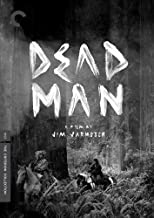
2. Dead Man
Whether or not this is Jim Jarmusch’s best film and one of Depp’s finest performances (yes to both, incidentally) is for list-makers and audiences to debate. What was obvious in 1995—and the last quarter century has made increasingly clear—is that Dead Man, aside from merely being a quiet masterpiece, is one of the best American films of the late ’90s. Despite the Criterion canonization, it will likely linger as a cult classic; too straightforward (relatively speaking) for Jarmusch enthusiasts, and too unorthodox for mainstream tastes.
It’s difficult to conceive another director who could flawlessly balance the literary (in this case, the razor-thin line of having a character named William Blake reciting lines by William Blake to a Native American, “Nobody”, played by Gary Farmer, who not only knows, but reveres the poems) and unadorned (we see horses pissing, prostitutes tossed into mud puddles, intimations of rape, and a little light cannibalism) quite like Jarmusch. Indeed, there are more than a few shocking moments, this being the Wild West after all, but there’s a deliberate, almost elegiac ambiance that seems more Ingmar Bergman than Sergio Leone.
It seemed then, and still does now, audacious that Jarmusch had the wherewithal to try his hand at a project to demystify (or, re-mystify) the he-man formulas that virtually all westerns are, by definition, obliged to prescribe to. Where much of his work, before and since, has a welcome air of improvisation and intentional messiness to it, Dead Man is admirably focused, with a discipline extending to everything from dialogue to specific shots, which cover the trek west, then northward. On a purely visual level, the film rewards multiple viewings, which is even more of an achievement considering Jarmusch decided to render these bucolic vistas entirely in black and white.
It’s not enough to describe Dead Man as simply an anti-western; it’s an iconoclastic deconstruction of late 19th Century American values and mores, many of which remain unabated more than a century later. There’s scarcely a symbol or sacred cow that does not become fair game: from the town of Machine, its bustling but soulless productivity a succinct commentary on the myriad backs broken to build America as an eventual world power; to the Dickensian office manager—John Hurt, like much of the star-laden cast, making the absolute most of his limited screen time—who is, like seemingly every office manager, at once officious and imperious; to the names and backstories of the protagonists, Depp’s William Blake (ignorant of his namesake’s work) and Gary Farmer’s Nobody (the Native American who knows enough for both of them—about literature and life); to the casually immoral mercenaries tracking Blake—providing potshots for all manner of lawful, lawless, and religious authority figures.
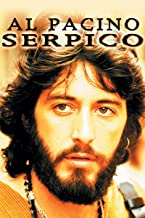
3. Serpico
So while I maintain I could never pick favorites, if I had to, I would probably suggest that Serpico, the first collaboration between Lumet and Pacino, represents the best work that either of them ever did. There is an unnerving scene, near the end of the film, that encapsulates the conundrum faced by the eponymous cop: already persona non grata within the law enforcement fraternity for his refusal to take bribes, Serpico is transferred to the narcotics division, where the beat is the exceedingly dangerous streets way off-Broadway. His new partner grimly explains that, compared to the types of kickbacks Serpico was accustomed to seeing, the haul in narcotics is serious business. “That is big money, that you do not fuck around with.” In this moment Serpico finally understands that his life is now in greater danger, amongst police officers than at the hands of criminals, because of his insistence on obeying the law.
I think this one scene, perhaps even more than anything in the embarrassment of riches that is Network, tells us all we need to know about how the world really works. Going back to the Watergate story, the reporters were advised to “follow the money”. That might be the most disturbingly succinct epitaph of our last century. Almost every act of violence and venality that we read about is prompted by the pursuit of money or the lack thereof, and most of all, the things money can’t buy (which, come to think of it, is the central theme of Lumet’s last, wonderful effort, Before The Devil Knows You’re Dead).
This film serves as a radical (and realistic) rewriting of the classic, and antiquated, American Dream myth, wherein the best man always wins, and good always prevails over evil. With an escalating irony that could only be culled from real life (otherwise it would be laughably implausible), the more he attempts to distance himself from the wrongdoing around him –which has casually corroded the department like a malignant infirmity– the more scorn he is subjected to.
Serpico, the man, and Serpico, the movie, are potent amalgams of, and commentaries upon, the country that made them. The idealizing, even naïve young man confronting corruption is arguably an invariable rite of passage for just about every individual who leaves the comforts –and conformity– of home for the bigger, badder realities of the world. When the individual is a police officer, and the subject of his disillusionment is the laissez-faire depravity of his precinct and, to a larger extent, the backbiting, political system as a whole, the stakes are raised rather considerably.
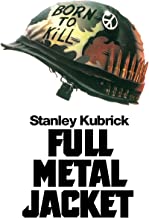
4. Full Metal Jacket
Has any director covered more ground, stylistically and historically, than Stanley Kubrick? From Lolita (1962) to The Shining (1980) to Eyes Wide Shut (1999) he made movies from books few directors could—or would—even consider adapting for the big screen. Incredibly, he made movies thatarguably transcended the source material; however much viewers (or the original authors) loved or loathed them, they most definitely were not deferential reproductions of the text.
Kubrick is famous—or infamous—for his meticulous, some might claim obsessive quest for “the perfect shot”; anecdotes abound of actors being forced to produce take after take to the point of exhaustion or distraction. His control freak tendencies may have had a great deal to do with the fact that he “only” made thirteen films over the course of a career that spanned five decades. On the other hand, it’s difficult to name many directors who made as many works that are today considered masterpieces, or a director who is cited more frequently for his innovation and influence. Detractors have claimed that his perfectionism resulted in films that were too cold or clinical; some find his work pretentious. Interestingly, if not revealingly, his work has aged well and seems to attract more converts (inside and out of critical circles) than detractors.
Full Metal Jacket is a naturalistic tour into the dark heart of modern war, preceded by a disquieting tour into the darkness of the hearts that prepare our soldiers to survive there. The second section, on the front lines, a surreal sort of cinéma vérité, is more plodding than cathartic, which is probably the point. The first part of the film, devoted entirely to a group of Marine recruits at Parris Island, is a quicksilver tour de force—at turns riotous and harrowing. It is some of the most assured, affecting work of the decade: not too many movies can take you from hysterical laughter (the initial scenes where drill instructor R. Lee Ermey lambastes the boys is piss-your-pants funny) to disgust and, inevitably, despair. The blanket party scene, where the incompetent “Gomer Pyle” (Vincent D’Onofrio) is savaged by his fellow cadets lingers in the mind as one of the most disturbing scenes in movie history. It manages to illustrate a great deal about conformity, the military, the perceived necessity of truly breaking someone before they can function and what we must kill inside ourselves in order to survive. Most directors would inexorably play this scene for pathos; Kubrick films it matter-of-factly and his shrewd use of subtlety makes it many times more disturbing.
Much more on Kubrick and his legacy, here.
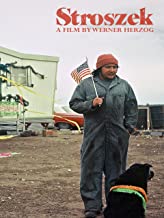
5. Stroszek
Few artists in any genre are as closely associated with the work they do. All of Werner Herzog’s films are to a certain extent autobiographical. It’s not merely a matter of how much of himself he invests into each project; it’s the nature of the projects themselves. Herzog has long combined creative restlessness with spiritual obsession and the results are often compelling, occasionally awe-inspiring and never less than interesting. He was the quintessential critical darling for entirely too long: he made movies that people admired, but he was anything but a household name. Never seeming to care—and certainly not one to covet notoriety—he quietly plugged along, keeping busy and remaining relevant. During the last decade his genius, and superhuman work ethic, have finally been recognized and rewarded.
It was not always thus. Herzog is possibly the ultimate underdog who inevitably got the acclaim and approbation he deserved. Herzog is undeniably a legend based solely on the stunning body of work he has produced. The real legend, of course, is his life and the excitement, misadventure and barely believable anecdotes it has inspired.
A stark, disconcerting and unforgettable experience, Stroszek is not a film one returns to for fun. It remains one of the most efficient and ruthless appraisals of the American Dream myth while managing to be amusing, touching and ultimately demoralizing. Using his infallible instincts, Herzog has non-actor Bruno S. embody the unlucky, exploited Stroszek. Fleeing Berlin for what they assume will be the warmer and more prosperous U.S.A., Stroszek and his companions end up in the frigid, desolate landscape of Wisconsin. The final scene, after things have gone predictably off the track, features Stroszek on a ski lift holding a frozen turkey. Beneath him, in coin-operated cages, a duck plays a drum with his beak, a rabbit “rides” a wailing fire truck and a chicken dances while the soundtrack features the ebullient harmonica woops of Sonny Terry. Arguably the most surreal, and satisfying, commentary on the human condition ever filmed: once you’ve seen it, it stays seen.
More on the eccentric and inimitable Werner Herzog, here.

6. Dreams
Understanding that Dreams was among the last films Akira Kurosawa made inexorably adds a regal and elegiac air to the proceedings. The fact that the work is semi-autobiographical (based on or inspired by actual dreams the legendary director had during the course of his life) renders the final product a rather intimate look into Kurosawa’s mind. Perhaps most intriguing is the unguarded way we are able to understand and appreciate the great man’s muse: we are in a sense seeing the way he saw, artistically. As such, Dreams could be considered the maestro’s most human film.
The concept, eight “dreams”, rendered as vignettes (or tone poems, or short stories, or fantastical reveries—or all of the above), could—and likely would—in almost any other director’s hands, be a recipe for farce. In fact, Dreams remains controversial and critical opinion on the film’s success is decidedly mixed. Those who dismiss it find the material mawkish, preachy and haphazardly constructed. Those who endorse it accept it on its own terms and relish the opportunity to explore Kurosawa’s creativity and, more than occasionally, his conscience. Perhaps more so than any other great director, Kurosawa was incapable of separating artifice from morality, and the tension of this human (and artistic) struggle recalls Dostoyevsky perhaps more than any filmmaker.
Special mention must be made of the film’s centerpiece, “Crows”, which involves an extraordinary encounter with Vincent Van Gogh (played, more than a little appropriately, by Kurosawa disciple Martin Scorsese). The famously tormented painter discusses “devouring” the natural scenes he paints, but admits “it’s so difficult to hold it inside.” If there is a better or more succinct explanation of the forces that inspired and destroyed this delicate man, I’ve yet to come across it. The only thing to do, he asserts, is work; to battle the inhibitions and push oneself past where even the demons can go. That way lays Glory and down there, deep, resides Beauty. And madness. “I drive myself like a locomotive,” he says, staring defiantly at the sun. What happens next, I’m not at all sorry to state, must simply be seen to be believed.

7. Blade Runner
The movie didn’t do especially well upon its release in 1982 and, with hindsight, seemed almost predetermined to become not merely a cult classic, but an archetype of sorts even within that refined category. Its ostensible flaws as commercial fare remain a credit to its intelligence and ambiguity—two attributes that don’t typically portend box office success. More, what begins as a standard action/detective story gradually expands to become a thoughtful meditation on morality, a tour de force of existentialism.
The 1992 Director’s Cut (which, aside from the insertion of one brief but crucial scene, is actually the unfettered original version) makes a compelling, even incontrovertible case that Deckard’s a replicant after all. Harrison hated the narration and, in fact, hoped by delivering it in a fashion somnolent even for him, it would be discarded. He should have known never to underestimate the judgment and intelligence of studio bosses. Ridley, on the other hand, has remarked that while he too loathed the narration, he felt it was sufficiently obvious Deckard was a replicant. (His sardonic, if refreshing take on the matter: “If you don’t know you are a moron.”)
With Roy Batty (an effulgent Rutger Hauer), the film takes a dramatic turn from detective procedural and turns typical theology upside down. The redeeming (and, redeemed) character is, in a sense, dying for the sins of others, but will receive neither reward nor restoration. Not for nothing does Tyrell, after confirming Batty’s worst fears, declare him to be “the prodigal son.” Certainly, one could make a career out of the religious imagery invoked throughout the narrative (the nails in the palms, the brutal beating he suffers, the futile entreaty to his creator, etc.).
On a purely practical level, if one reckons that the ends justify the means, the notion of using Christ as a model is commendable, particularly when it results in the pursuit of reconciliation over aggression. Indeed, the idea that organized religion was designed as a self-perpetuating (and quite effective) system to organize and supervise the masses is unoriginal enough to be dismissed as cliché. And yet, considering the ultimate objective of Christian fellowship is to inspire conduct sufficient to earn everlasting life, it’s difficult to argue which is more disingenuous: the self-serving ecclesiastics or those who see through it, yet utilize it for personal gain or to consolidate control.
The figure of Christ is enduringly appealing, as a literary figure, for His acts of kindness and care. But concerning the biblical moments of transcendence, the miracles distance Him from us; whereas Batty’s final gesture is made with the understanding that he’ll gain no favors, here or elsewhere. As such, it would cheapen his sacrifice to give Christianity unearned credit and declare this an act of Christ-like mercy; rather, it’s an enduring gesture of human grace. As such, it remains a persuasive and provocative advertisement for what we’re capable of when we’re most fully human or more, when we transcend our inherent (see: selfish) human limitations. Blade Runner remains the ultimate paradox: a movie about the impermanence—even the construction—of humanity, yet it makes one of the greatest cases for compassion and charity.
More about the movie, the book it’s based on, and it’s myriad implications, here.
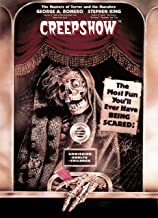
8. Creepshow
If you are of a certain age, you certainly remember the supremely cheesy early-’80s horror flick Creepshow. If you succeeded in growing up, literally and figuratively, you quickly forgot about it. But here’s the funny thing: it wasn’t as bad as you remember; in fact, the only parts that remain awful are the parts that were supposed to be scary, which would explain why it kind of sucked when you first saw it as a teenager.
The scary parts are funny, and the funny parts (mostly) funny, and then the unforced parts are wonderfully unsettling. Seriously: the last episode, with the wealthy, Machiavellian scumbag whose only soft spot was a profound fear of insects? How many of today’s Wall Street masters of the universe would you love to see that scene happen to? Or enjoying Hal Holbrook ham it up with the cellar-dwelling stuffed animal who ravages the delectable Adrienne Barbeau (did someone say early ’80s and “target audience”)? Or Stephen King doing some of the worst acting in film history, yet still managing to put in a better performance than 90% of the movies made from his books? Good stuff abounds, and it might best endure as a film that (gasp) adults can actually enjoy. Now that is horrifying.
Right in the middle, sandwiched between King turning green and Barbeau’s bosom, is the segment that manages to represent the best and worst elements of what made this movie so wonderfully awful. Needless to say, it features Nielsen. He is the cuckolded husband who happens to be jealous, wealthy, and –as his wife and her lover find out– more than a little psychotic. Whether or not this is ultimately worthwhile material (for my money, it is), this is one of those roles that can –and should– function as a cinematic case study: any other actor playing Nielsen’s role could not have risen above the ridiculous dialogue and too-campy-by-half histrionics that ensue. Nielsen, equal parts wise-ass, weasel and, at this point in his career/life, still able to cut an imposing figure (he was not a small man), suffuses fake charm, menace and ill-will. And then he really gets down to business.
He manages to seem somewhat pathetic, and in another bit of brilliant and more than slightly perfect casting, (which seems uncannily prescient in hindsight) the very suave and masculine Ted Danson is his foil. This, mind you, is the then-unknown Ted Danson, pre Sam Malone and Cheers, so it’s hilarious in its own way to see a man who would become one of America’s TV immortals all through the ’80s sucking seaweed in this B-minus movie.
Can you handle more? If so, go here.

9. Walkabout
There are those special movies that change your life after you’ve seen them. Then there are the almost miraculous movies that stay inside you and then change your life again every time you return to them.
Question: what makes this one of the landmark films of the last half-century? Answer: as a near perfect amalgamation of image, story and sound, Walkabout remains vital — and provocative — for its ability to present complicated questions that cannot (and need not) readily be answered. Like any memorable work of art, this movie manages to convey certain elusive insights that, upon reflection, are so obvious they seem revelatory.
The action — and conflict — gets underway quickly when a teenager and her younger brother are stranded in the desert after their father abandons them in a most unsettling fashion. An unexpected salvation arrives when the children encounter a native (David Gulpilil) who is undertaking his walkabout, a solitary excursion Aborigine males embark upon as the symbolic entrance into adulthood. The young man, roughly the same age as the sister, is unable to speak their language but eventually comprehends their distress. In a matter of moments we see him find water and hunt his food, an almost offhand commentary on the way he thrives in an environment that would have killed the children.
In the days that follow the children are taught — and begin imitating — techniques for survival, and a gentle, mutual bond is established. Stripped of her cultural ascendancy, the girl is at once grateful for and humbled by the Aborigine’s presence. The younger brother, less guarded and more innocent, is able to communicate without speaking, using gestures and sounds. The sister becomes increasingly cognizant of her surroundings, and a connection to the land that is much less tenuous than she could ever have imagined while ensconced in the secure routine of an urban existence.
A lot more on a movie I could not recommend more highly, here.
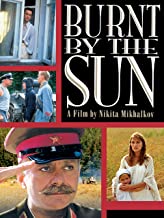
10. Burnt by the Sun
This is perhaps the only film from the last 30 years where I agree with virtually every critique (of which there are many, aside from the contrarian cranks who feel obliged to find fault with any movie fortunate enough to be lavished with awards), yet still consider it a near-masterpiece. Is it, at times, heavy-handed? Da. Can it fairly be accused of occasional preciousness? Da. Sentimental? Da. Still, and I measure my words carefully here, so was Tolstoy. Am I comparing this film to Tolstoy? Sort of. It is undoubtedly the most accurate, or at least successful, depiction of what we might call “Tolstoyan” (Memento, incidentally, is for my money the most “Dostoyevskian”).
This invocation is not offered lightly: the (very impressive) number of characters, the scope of its political, social and romantic entanglements, the sense of history anticipating the future even as the future seems to mockingly distort memory and deed, the violence and tenderness—occasionally contained in the same gesture; all of these are indelible elements of great Russian literature. If nothing else, Mikhalkov should be celebrated for the audacity to throw his cap in the big arena and go for broke.
Like most masterful movies, Burnt By The Sun can be appreciated for its succession of unforgettable scenes: Kotov explaining war and peace to his young daughter by admiring her soft and unscarred feet; Mitia correcting his servant’s pronunciation while carefully loading his pistol; the peasant driving in circles all day, looking for a town that never existed; Mitia playing the piano while wearing a gas mask—and the moment he locks eyes with Kotov across the room: a short and subtle exchange that shifts the entire momentum of the movie; Mitia standing fully clothed in the creek, reciting (in broken English) from Hamlet…these are all astonishing gifts that can be savored again and again.

